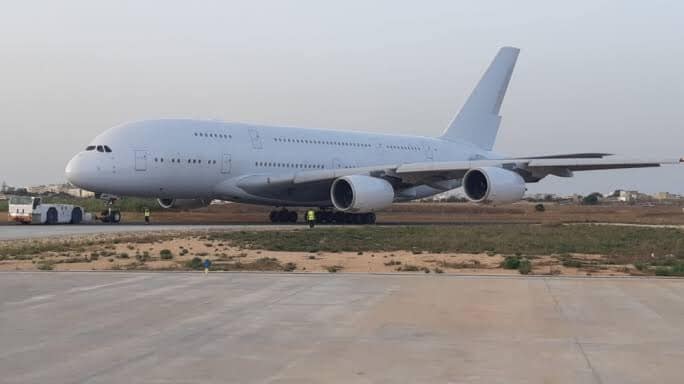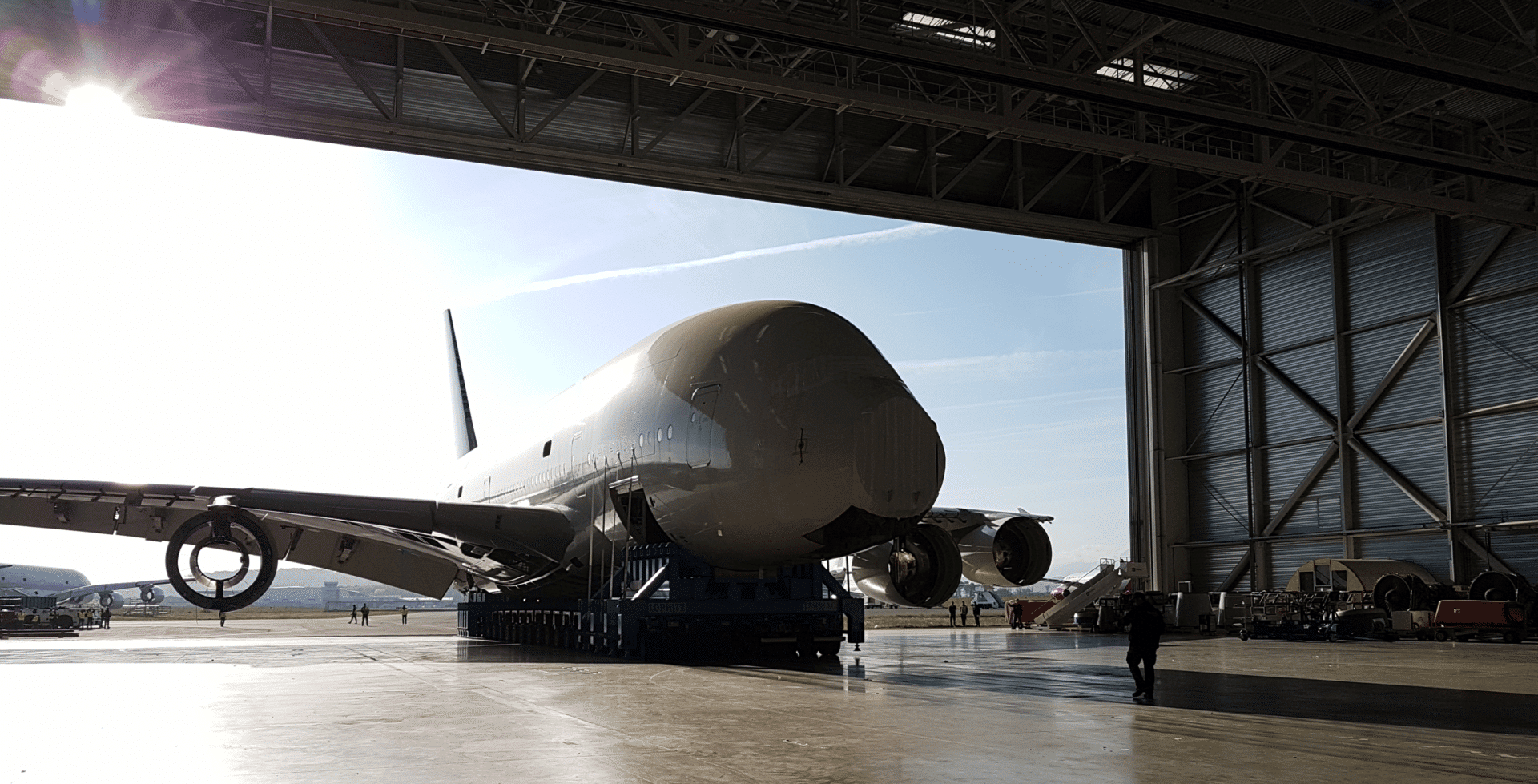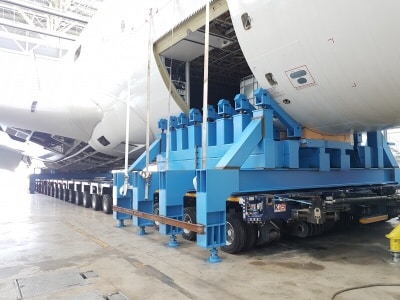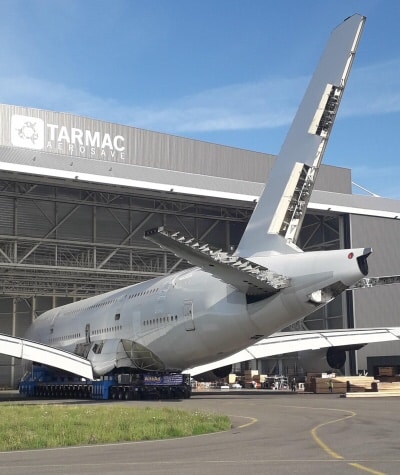Aviation
First A380 Dismantling project completed : TARMAC Aerosave

TARMAC Aerosave, the leading aircraft storage, maintenance and recycling company in Europe, has just completed the first ever A380 dismantling project, a pioneering operation that was announced a year ago. Already recognised as the expert in storage for this superjumbo jet, TARMAC Aerosave is bringing the three other major areas of competence in the Pyrenean group to bear on this aircraft: transition, recycling and very soon maintenance, a B check being announced for March.

TARMAC Aerosave has completed the first A380 dismantling project, which was launched at the beginning of this year. TARMAC Aerosave managed this project in collaboration with the aircraft owner, the German Dr Peters company, and the end of life manager, the American company VAS Aero Services for the sale of the spare parts.
This A380 benefited from the TARMAC Aerosave’s exclusive eco-responsible services (cold-cutting, lubricating, draining, selective sorting) which made it possible to recycle over 90% of the overall mass. Spare parts are thus now available on the pre-owned market. A second dismantling project is under way.

It is now time to analyze the feedback after this operation, which required the development of new processes and made-to-measure tools. The complex dismantling of all of the parts required all of the expertise of TARMAC Aerosave in the design of cradles and fuselage-moving equipment.
During the dismantling phase for heavy parts at height, personnel safety procedures were strengthened.
Emirates announces start of scheduled A380 service into Hamburg
Future A380 storages and transitions
Since it is TARMAC Aerosave’s first activity, other aircraft of this type are currently in storage and in transition. The French group is in fact offering its hangars and parking areas that have been specially built for the A380, on its site at Tarbes. The same capacity is being developped in Teruel (Spain). Maintaining them in operational condition makes it possible for them to re-enter service at any moment.
Since 2007, 560 aircraft from all manufacturers, out of a total of 850 stored, have re-entered service.

TARMAC Aerosave is announcing that a B Check will take place in March 2020.
Already certified for all types of maintenance on commercial airplanes, TARMAC Aerosave is adding this service to its “one-stop-shop” offer. For A380’s, TARMAC Aerosave also has expertise in cabin modification and technical uprating based on the manufacturer’s latest recommendations
Airbus BelugaXL enters service, adding XL capacity to the fleet
(Implementation Service Bulletins)
TARMAC Aerosave’s transition centre is now able to ensure all types of operations relating to management of an airplane withdrawn from service and throughout its life cycle. This is the only service of this type on offer worldwide.
“We are very proud of these industrial successes, obtained with the largest airplane currently in service in the world. TARMAC Aerosave is pursuing its goals in innovation and adaptation in the air transport market, anticipating its customers’ needs and the evolution of environmental standards.” says Patrick Lecer, President of TARMAC Aerosave.

Aviation
Airbus Enhances A350 Cabin with 10-Abreast Seating

Airbus has announced a new partnership with Jiatai Aircraft Equipment, a Chinese aircraft seating manufacturer, to supply upgraded economy-class seats for the A350 widebody series.
This collaboration, unveiled at the 2024 Airshow China, focuses on developing a newly designed economy seat tailored for the A350‘s New Production Standard (NPS) cabin.
One of the key features of the NPS cabin is the ability to accommodate 17-inch wide economy seats, compared to the previous 16.5-inch wide seats that airlines were limited to in the A350’s earlier configurations.
British Airways Unveils Its Brand-New First Class Cabin for the Airbus A380
This change is made possible by the expanded space in the NPS cabin, which is 35 inches longer and 4 inches wider than the previous version. This extra space is achieved by slightly moving the cockpit wall forward and shifting the rear pressure bulkhead back by one frame.
The wider cabin allows airlines to add up to 30 extra economy seats without compromising comfort. For airlines opting for a 3-4-3 seating layout, the 17-inch wide seats are an excellent choice for a more comfortable passenger experience. However, some airlines, such as Iberia, may choose to retain a 9-abreast layout with wider seats for added comfort.
The NPS cabin also offers enhanced flexibility for airline operators. One major advantage is the ability to easily switch between a 9-abreast and 10-abreast seating configuration without requiring significant downtime for aircraft reconfiguration. Airlines can use the same seat rails, tracks, and IFE interfaces, making the transition smoother and quicker.
Etihad Airways Unveils 10 Exciting New Routes for 2025
In addition, the design of the floor attachments and air-conditioning systems has been optimized for 10-abreast seating, meaning airlines can upgrade their cabins without needing to make substantial modifications to the aircraft’s structure.
Though it’s still unclear when Jiatai’s economy-class seats will be officially added to the A350’s Buyer Furnished Equipment (BFE) catalogue, the collaboration marks a significant step toward enhancing the A350’s cabin offerings.
With this partnership, Airbus is providing more seating options for airlines, ensuring that they can meet diverse customer needs while improving overall operational efficiency.
-

 Aviation2 months ago
Aviation2 months agoMicrosoft Flight Simulator Raises $3 Million to Bring Back the An-225 Mriya
-

 Airlines2 months ago
Airlines2 months agoQatar Citizens Can Travel to the United States Without a Visa
-

 Aviation2 months ago
Aviation2 months agoQatar Airways bans these new Electronic Devices on plane
-

 Airlines2 months ago
Airlines2 months agoJapan Airlines Rolls Out Free Domestic Flights to International Passengers
-

 Travel2 months ago
Travel2 months agoQatar Airways Launches Four Additional Flights from Amsterdam
-

 Defence2 months ago
Defence2 months agoWhich Country Has the Largest Fleet of Fighter Aircraft?
-

 Airport2 months ago
Airport2 months agoWestern Sydney Airport Welcomes Its First Plane After 6 Years of construction
-

 Airlines4 days ago
Airlines4 days agoDAMAC Air: Dubai’s New Luxury Airline Offers Free Flights for Registration








